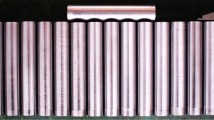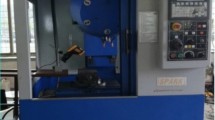Abstract
The machining of stainless steel is of interest because of its corrosion resistance and high strength. Usually, this process involves the application of cutting fluids, which negatively affect the environment, ecologic, and health impacts. Therefore, dry machining is the optimum solution, when applicable. Moreover, due to the high cost of cubic boron nitride (CBN) cutting edge, the improved performance is important for hard finish turning. Reducing energy consumption under dry condition should consider for sustainable machining. This study aims to optimize machining parameters (i.e. power consumption and surface roughness) of stainless steel 316 with CBN tool under dry conditions. A multi-responses based on response surface methodology with Box-Behnken design (BBD) was employed to optimize machining parameters. A compound desirability function was applied to determine optimum levels and contribution of parameters. A validation test was conducted to confirm results. This combination of parameters resulted in the minimum power consumption of 6.78% and decreased surface roughness by 13.89%. This method also effectively reduces the environmental effects in terms of noncutting fluid use and less energy required which is affected in sustainable of machining.
Similar content being viewed by others
References
Pusavec F, Krajnik P, Kopac J (2010) Transitioning to sustainable production–part I: application on machining technologies. J Clean Prod 18(2):174–184. https://doi.org/10.1016/j.jclepro.2009.08.010
King N, Keranen L, Gunter K, Sutherland J (2001) Wet versus dry turning: a comparison of machining costs, product quality, and aerosol formation
Jayal AD, Badurdeen F, Dillon OW, Jawahir IS (Jan. 2010) Sustainable manufacturing: modeling and optimization challenges at the product, process and system levels. CIRP J Manuf Sci Technol 2(3):144–152. https://doi.org/10.1016/j.cirpj.2010.03.006
Jawahir IS, Attia H, Biermann D, Duflou J, Klocke F, Meyer D, Newman ST, Pusavec F, Putz M, Rech J, Schulze V, Umbrello D (Jan. 2016) Cryogenic manufacturing processes. CIRP Ann - Manuf Technol 65(2):713–736. https://doi.org/10.1016/j.cirp.2016.06.007
Danish M, Ginta TL, Habib K, Carou D, Rani AMA, Saha BB (Jul. 2017) Thermal analysis during turning of AZ31 magnesium alloy under dry and cryogenic conditions. Int J Adv Manuf Technol 91(5–8):2855–2868. https://doi.org/10.1007/s00170-016-9893-5
Dixit US, Sarma DK, Davim JP (2012) Environmentally friendly machining. Springer US, Boston, MA. https://doi.org/10.1007/978-1-4614-2308-9
Schultheiss F, Zhou J, Gröntoft E, Ståhl J (2013) Sustainable machining through increasing the cutting tool utilization. J Clean Prod 59:298–307. https://doi.org/10.1016/j.jclepro.2013.06.058
R. Nur, M. Y. Noordin, S. Izman, and D. Kurniawan (2015) Machining parameters effect in dry turning of AISI 316L stainless steel using coated carbide tools. Proc Inst Mech Eng Part E J Process Mech Eng, p. 954408915624861
Yoon H-S, Kim E-S, Kim M-S, Lee J-Y, Lee G-B, Ahn S-H (2015) Towards greener machine tools–a review on energy saving strategies and technologies. Renew Sust Energ Rev 48:870–891. https://doi.org/10.1016/j.rser.2015.03.100
EIA (2013) International Energy Outlook 2013, US Energy Inf. Adminis- tration, p. 312
IEA (2017) CO2 emissions from fuel combustion
Kalpakjian S, Schmid S (2006) Manufacturing, engineering and technology SI 6th Edition. Digital Designs
Wegener K, Kuster F, Weikert S, Weiss L, Stirnimann J (2016) Success story cutting. Procedia CIRP 46:512–524. https://doi.org/10.1016/j.procir.2016.04.110
Davoodi B, Eskandari B (2015) Tool wear mechanisms and multi-response optimization of tool life and volume of material removed in turning of N-155 iron-nickel-base superalloy using RSM. Meas J Int Meas Confed 68:286–294. https://doi.org/10.1016/j.measurement.2015.03.006
Bouacha K, Yallese MA, Mabrouki T, Rigal J-FFF (2010) Statistical analysis of surface roughness and cutting forces using response surface methodology in hard turning of AISI 52100 bearing steel with CBN tool. Int J Refract Met Hard Mater 28(3):349–361. https://doi.org/10.1016/j.ijrmhm.2009.11.011
Huang Y, Chou YK, Liang SY (Nov. 2007) CBN tool wear in hard turning: a survey on research progresses. Int J Adv Manuf Technol 35(5–6):443–453. https://doi.org/10.1007/s00170-006-0737-6
Bagaber SA, Yusoff AR (2017) A comparative study on performance of CBN inserts when turning steel under dry and wet conditions. IOP Conf Ser: Mater Sci Eng 257(1):12041. https://doi.org/10.1088/1757-899X/257/1/012041
Camposeco-Negrete C (2015) Optimization of cutting parameters using response surface method for minimizing energy consumption and maximizing cutting quality in turning of AISI 6061 T6 aluminum. J Clean Prod 91:109–117. https://doi.org/10.1016/j.jclepro.2014.12.017
Bagaber SA, Yusoff AR (2017) Multi-objective optimization of cutting parameters to minimize power consumption in dry turning of stainless steel 316. J Clean Prod 157:30–46. https://doi.org/10.1016/j.jclepro.2017.03.231
Bagaber SASA, Yusoff ARAR (2017, 1828) Effect of cutting parameters on sustainable machining performance of coated carbide tool in dry turning process of stainless steel 316. AIP Conf Proceed:20013
Box GEP, Wilson KB (1992) On the experimental attainment of optimum conditions. In: Breakthroughs in statistics. pp 270–310
Rao RV, Kalyankar VD (2014) Optimization of modern machining processes using advanced optimization techniques: a review. Int J Adv Manuf Technol 73(5-8):1159–1188. https://doi.org/10.1007/s00170-014-5894-4
Korloy (2015) Korloy Cutting Tools, pp. 1–1059
Berkani S, Yallese MA, Boulanouar L, Mabrouki T (2015) Statistical analysis of AISI304 austenitic stainless steel machining using Ti(C, N)/Al2O3/TiN CVD coated carbide tool. Int J Ind Eng Comput 6(4):539–552. https://doi.org/10.5267/j.ijiec.2015.4.004
Camposeco-Negrete C (2013) Optimization of cutting parameters for minimizing energy consumption in turning of AISI 6061 T6 using Taguchi methodology and ANOVA. J Clean Prod 53:195–203. https://doi.org/10.1016/j.jclepro.2013.03.049
Hanafi I, Khamlichi A, Cabrera FM, Almansa E, Jabbouri A (2012) Optimization of cutting conditions for sustainable machining of PEEK-CF30 using TiN tools. J Clean Prod 33:1–9. https://doi.org/10.1016/j.jclepro.2012.05.005
Azam M, Jahanzaib M, Wasim A, Hussain S (2015) Surface roughness modeling using RSM for HSLA steel by coated carbide tools. Int J Adv Manuf Technol 78(5–8):1031–1041. https://doi.org/10.1007/s00170-014-6707-5
Khamel S, Ouelaa N, Bouacha K (2012) Analysis and prediction of tool wear, surface roughness and cutting forces in hard turning with CBN tool. J Mech Sci Technol 26(11):3605–3616. https://doi.org/10.1007/s12206-012-0853-1
Kant G, Sangwan KS (2014) Prediction and optimization of machining parameters for minimizing power consumption and surface roughness in machining. J Clean Prod 83:151–164. https://doi.org/10.1016/j.jclepro.2014.07.073
Acknowledgments
The authors would like to thank the University Malaysia Pahang for providing laboratory facilities. The finances provided by Universiti Malaysia Pahang through GRS (20.03/13) is also acknowledged.
Author information
Authors and Affiliations
Corresponding author
Rights and permissions
About this article
Cite this article
Bagaber, S.A., Yusoff, A.R. Multi-responses optimization in dry turning of a stainless steel as a key factor in minimum energy. Int J Adv Manuf Technol 96, 1109–1122 (2018). https://doi.org/10.1007/s00170-018-1668-8
Received:
Accepted:
Published:
Issue Date:
DOI: https://doi.org/10.1007/s00170-018-1668-8




